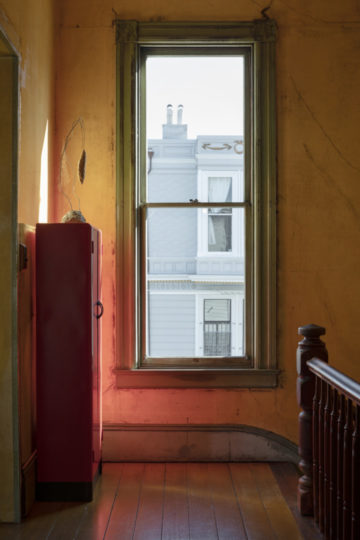
Originally published in the Marina Times San Francisco in April 2020
“You can’t make art by making art” is one of assemblage artist David Ireland’s best-known quotes used to describe his practices during his career.
As an environment and living artwork, Ireland’s home at 500 Capp Street became not just a dwelling but also an idiosyncratic assemblage of his creative vision. Ireland came to be a full-time artist at the age of forty after earning a Bachelor of Applied Art degree from California College of the Arts, serving in the military, raising a family while working in insurance, carpentry and even traveling the world as a safari guide and importer of artifacts.
After spending time in New York, Ireland returned to San Francisco and became a part of the Bay Area Conceptual movement which included artists like Terry Fox, Howard Fried, Paul Kos, Tony Labat and Jim Melchert. The group helped establish San Francisco as a key location in conceptual art through video, performance and installation art.
The Beginning of 500 Capp St.
All of these experiences informed David Ireland’s site-specific installation pieces consisting of everyday objects that explore ideas of place and transformation utilizing everything from phone books to cement to discarded furniture. When he bought the Victorian home on 500 Capp St. in 1975, he applied his sense of minimalism and absurdity to transform the space. By exploring the beauty of everyday things, Ireland became an accessible conceptual artist for audiences that wouldn’t normally have the patience for the medium. Ireland liked to play with the idea of a functional space, personal possessions that double as family heirlooms and art in an exhibit simultaneously, and the humor that comes from that shifting meaning and adaption. He also emphasized the transformation that occurs in structural objects, for example cement which changes from liquid to solid. Twentieth century art has a rich history of artists wanting to become a part of their own work, artists like Joseph Beuys whose conceptual installation “I like America and America Likes Me” (1974) consisted of the artist living in a performance space for three days with a coyote. Marcel Duchamp, whose art and wry humor influenced Ireland’s methodologies, also believed in merging art with life and said “Anything is art if the artist says it is.”
The David Ireland House Restoration
Ireland moved out of his home into an assisted living facility and died in 2009. In January 2016, Jensen Architects and ARG Conservation Services began a thorough restoration and conservation campaign to crate public access to the home and improve the conditions for the art without altering the original spaces. Some additions were made so that The House now utilizes the full footprint of the property and includes new exhibition spaces. An archive room was added for even more of Ireland’s work as well as a terrace and spaces to accommodate public events related to the 500 Capp Street Foundation. The exterior paint of the The House was restored to its original “battleship grey”, and the iconic gold leaf signage on the front window and “500” address number were returned to their original condition.
Ireland’s work has been presented in more than forty solo exhibitions at venues including the Walker Art Center, Minneapolis; Hirshhorn Museum and Sculpture garden; Smithsonian Institution, Washington D.C.; The Museum of Modern Art, New York; and the Museum of Contemporary Art, New York. The Oakland Museum of California organized the first full-scale traveling retrospective of his work which included key pieces related to 500 Capp. Street.
Admittance to the David Ireland house is free to the public, and the space will be hosting exhibits from visiting artists. Through June 27th, the David Ireland house will feature an exhibit by Felipe Dulzaides There is no such thing as a perfect circle. In exploring subjects relating to the circle as an image, the circle as a subject of cultural displacement, and the social meaning of circularity, dislocation and relocation. Now residing in Havana, Dulzaides lived in San Francisco from 1998 to 2010. He met Ireland while he was a student at the San Francisco Art Institute where Dulzaides earned a MFA in 2001 and taught over a decade. In Cuba, he has developed Centro Bahia, an architectural interdisciplinary art space. The exhibit reflects on his friendship with Ireland and includes mixed media work documenting the creation of Centro Bahia.
Guided tours are available on Wednesdays, Thursdays and Fridays at 2 and 4 pm, and self-guided tours on Saturday from 12 to 5pm.